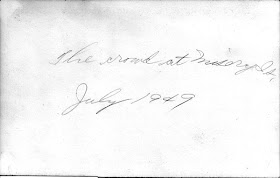MUNROE
 |
| Here Lyes ye Body of Mr. WILLIAM MUNROE Aged About 90 Years Dec'd Jan 27, 1718 |
The Munroe name is well known in Lexington because of the
Revolutionary War. The first Munroe in
my lineage came to Massachusetts as a prisoner of war. William Munroe, and his two brothers, were
Scots captured at the Battle of Worcester in England in 1651. They were shipped to London and packed aboard
the “John and Sara” to be sold into servitude in Boston, Massachusetts. William was free by 1657 when he was fined in
Cambridge for not having a ring in the noses of his pigs. By 1660 he had removed to Cambridge Farms,
near the Woburn line, to a part of town that became known as “Scotland”. It is now known as the town of Lexington.
What is interesting to me is that apparently the Munroe clan
harbored somewhat of a grudge against the British. In 1775, when the British marched on
Lexington, the sergeant of the militia was another William Munroe, great grandson
of the immigrant William. He owned the
Munroe Tavern and led a group in which about one third were his kinsmen (other
Munroes, cousins, and relations). He
entertained George Washington at the tavern in 1789 when he visited Lexington
to thank the townspeople for their participation in the American
Revolution.
There are many books with information on the Munroe family,
but the three best are:
A Sketch of the Clan Munro and William Munroe, Deported from Scotland,
settled in Lexington, Massachusetts by James Phinney Munroe
History and Genealogy of the Lexington, Massachusetts Munroes
by Richard S. Munro, 1966
History of the Town of Lexington, Middlesex County, Massachusetts
by Charles Hudson of the Lexington, Massachusetts Historical Society, 1913
(with genealogies)
Also, the Lexington Historical Society owns the Munroe
Tavern and has much information on the Munroe family in their archives. Please see the website http://lhsoc.weebly.com/ for more
information. The official Clan Munro
website is www.clanmunrusa.org and
their website has much information on the Lexington family. The 2012 Munroe clan gathering will be in
Boston August 9 – 12, 2012 and details are available at http://clanmunrousa.org/wp/?page_id=197
I have many stories about the Munroe family here on my blog. You may access them all at this link: http://nutfieldgenealogy.blogspot.com/search/label/Munroe
---------------------------------
My Munroe lineage:
1. William Munroe, born about 1625 near Inverness, Scotland,
and died 27 January 1718 at Lexington, Massachusetts; married first about 1665 to
Martha George, daughter of John George and Elizabeth Unknown; married second
about 1672 to Mary Ball, daughter of John Ball and Elizabeth Pierce; and
married third after 1693 to Elizabeth
Johnson, daughter of William Johnson and Elizabeth Story. He had four children by Martha and ten
children by Mary.
2. George Munroe, born about 1672 in Lexington, and died 17 January 1747 in Lexington. He married Sarah Mooers, daughter of Jonathan
Mooers and Constance Langthorne. They
had nine children.
3. Andrew Munroe,
baptized 4 June 1718 in Lexington, and
died 16 September 1766 in Lexington; married on 26 May 1763 to Lucy Mixer,
daughter of Joseph Mixer and Mary Ball.
They had two children, and Lucy remarried on 6 December 1774 in Woburn
to Caleb Simonds.
4. Andrew Munroe,
Junior, born on 31 March 1764 in Lexington, an died 7 August 1836 in Danvers,
Massachusetts; married on 22 March 1785 in Burlington to Ruth Simonds, daughter
of Caleb Simonds and Susanna Converse, his step-sister. They had eleven children. Andrew Munroe was a Major in the American
Revolutionary War.
5. Luther Simonds
Munroe, born on 10 May 1805 in Danvers, and died 23 December 1851 in Danvers;
married on 3 September 1826 in Reading, Massachusetts to Olive Flint, daughter
of John Flint and Phebe Flint. They had
six children.
6. Phebe Cross Munroe, born 28 October 1830 in Danvers, and
died 31 January 1895 in Salem, Massachusetts; married on 24 November 1853 in
Danvers to Robert Wilson Wilkinson, son of Aaron Wilkinson and Mercy F. Wilson.
Three children.
7. Albert Munroe
Wilkinson, born 7 November 1860 in Danvers, and died 12 May 1908 at Corey Hill
Hospital in Brookline, Massachusetts due to complications of a gall bladder
surgery; married on 18 October 1894 in
Salem to Isabella Lyons Bill, daughter of Caleb Rand Bill and Ann Margaret
Bollman.
8. Donald Munroe Wilkinson and Bertha Louise Roberts, my grandparents.
------------------------
To Cite/Link to this blog post: Heather Wilkinson Rojo, "Surname Saturday ~ Munroe of Lexington, Massachusetts", Nutfield Genealogy, posted June 30, 2012, ( https://nutfieldgenealogy.blogspot.com/2012/06/surname-saturday-munroe-of-lexington.html: accessed [access date]).


.JPG)
.JPG)
+-+Copy.JPG)
.JPG)







+-+Copy.JPG)
.JPG)





























.JPG)







